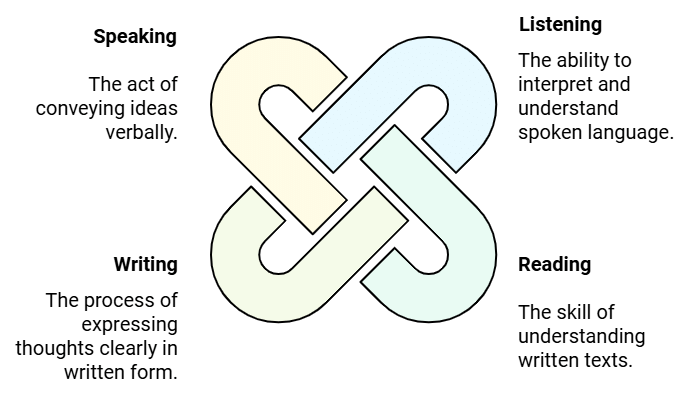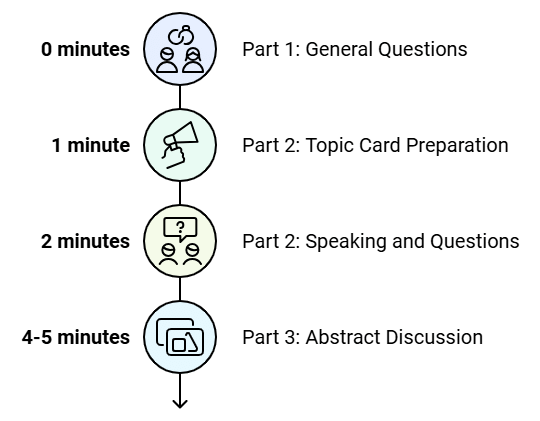Speaking Module for IELTS: Exam Pattern & Scoring | Speaking for IELTS PDF Download
Jumping into details of what exactly is in the IELTS test, it is important to know that the exam comprises four sub-sections that test your language ability on individual grounds.
You must not forget that collective knowledge of all these modules is essential to call yourself an expert user of the English language.
What are the sub-sections?

The sub-sections of the IELTS exam are rendered as the modules of IELTS. There are simply 4 modules, namely:
- Listening
- Reading
- Writing
- Speaking
You can find all the modules for practice on the EduRev app by clicking here.
Let us Discuss the Speaking Module in Detail
The speaking section assesses your use of spoken English. Every test is recorded. The test is taken in three parts. Below given are the details for all the parts.

Part 1: The examiner will ask you general questions about yourself and a range of familiar topics, such as home, family, work, studies and interests. This part lasts between four and five minutes.
Part 2: You will be given a card which asks you to talk about a particular topic. You will have one minute to prepare before speaking for up to two minutes. The examiner will then ask one or two questions on the same topic.
Part 3: you will be asked further questions about the topic in Part 2. These will give you the opportunity to discuss more abstract ideas and issues. This part of the test lasts between four and five minutes.
IELTS Speaking description
Paper format: The Speaking test consists of an oral interview between the test takers' and an examiner. All Speaking tests are recorded.
Timing: 11–14 minutes
Task types: There are three parts to the test and each part fulfills a specific function in terms of interaction pattern, task input and test takers output.
IELTS Speaking in detail
A detailed look at the paper with links to related resources.
Part 1: Introduction and interview
Task type and format: In this part, the examiner introduces him/herself and checks the test takers' identity. They then ask the test takers general questions on some familiar topics such as home, family, work, studies and interests. To ensure consistency, questions are taken from a script. Part 1 lasts for 4–5 minutes.
You can prepare for this section from EduRev by clicking here.
Task focus: This part of the test focuses on the ability to communicate opinions and information on everyday topics and common experiences or situations by answering a range of questions.
Part 2 – Long Turn
- Task type and format: Part 2 is the individual long turn. The examiner gives the test takers a task card which asks the test takers to talk about a particular topic, includes points to cover in their talk and instructs the test takers to explain one aspect of the topic. Test takers are given one minute to prepare their talk, and are given a pencil and paper to make notes. The examiner asks the test takers to talk for 1 to 2 minutes, stops the test takers after 2 minutes, and asks one or two questions on the same topic.
- Using the points on the task card effectively, and making notes during the preparation time, will help the test takers think of appropriate things to say, structure their talk, and keep talking for 2 minutes. Part 2 lasts 3–4 minutes, including the preparation time.
- Task focus: This part of the test focuses on the ability to speak at length on a given topic (without further prompts from the examiner), using appropriate language and organizing ideas coherently. It is likely that the test takers will need to draw on their own experience to complete the long turn.
You can prepare for this section from EduRev by clicking here.
Part 3 – Discussion
Task type and format: In Part 3, the examiner and the test takers discuss issues related to the topic in Part 2 in a more general and abstract way and, where appropriate, in greater depth. Part 3 lasts 4–5 minutes.
EduRev has compiled a complete course for this section, check it out here.
Task focus: This part of the test focuses on the ability to express and justify opinions and to analyze, discuss and speculate about issues.
FAQs about IELTS Speaking
How can I score good bands in speaking?
If you wish to achieve your desired band score in the IELTS Speaking test, make sure you put check on the following key elements :
Fluency and coherence
Usage of Lexical resource
Wide Grammatical range and good accuracy
Correct Pronunciation
Click here for a detailed course for the IELTS Speaking module.
|
33 videos|169 docs
|

















